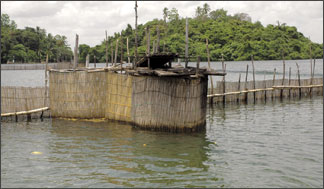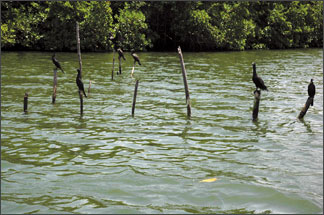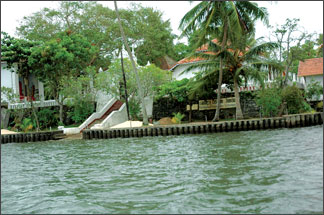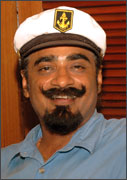Nestling with nature at Madu Ganga
Sachitra Mahendra and Ruwini Jayawardana

The Five-cent Island |

Facade of Gangabada Walauva |

Entrance to the hotel |

Shrimp farming |

Birds roosting |

Koth Duwa Raja Maha Viharaya |
|

“We encourage guests to feast their eyes upon nature’s
exceptional beauty. We offer them facilities to camp outdoors in
the islets and to go on bird watching expeditions. We also have
a deep sea fishing programme at Gendawanagala
in January,” - Pradeep Chandana de Silva
|
Surrounded by a thick jungle of mangroves, radiant waters and the
bliss of Sri Lankan natural habitat lies one of the island's most
prolific inland rivers - Madu Ganga. Located in the southern coast of
Balapitiya, past Ahungalle, Madu Ganga is located 80 kilometres from
Colombo and 55 kilometres from Galle.
Madu Ganga is regarded as Sri Lanka's second largest wetland
consisting 915 hectares. It was originally said that the wetland was
flanked by 64 islands but only 25 remain today. Ma Duwa is the largest
among them and shelters around 500 families while the smallest is the
Sata Paha Doopatha (The Five-cent Island) which resembles a five-cent
coin. It houses a small Devale (shrine room) in which stands a
half-built statue of god Katharagama. Legend has it that nobody can
complete the statue as misfortune befalls on them. The Nai Doopatha and
the Dimi Doova are both used by the villagers to dump snakes and red ant
nests.
A beguiling aspect of Madu Ganga is probably its calm and unruffled
nature. The mangroves provide home for many aquatic plants and animals
including a variety of birds, fish, crabs, shrimp and fauna. While
enjoying a boat ride along the river visitors are able to catch glimpse
of around 10 verities of plants endemic to Sri Lanka. The Xanochnpis
asperriums, a variety of water snake which is fast becoming extinct is
one of the species which dwells in the waters of the river. Out of Sri
Lanka's 226 varieties of birds around 86 find shelter in Madu Ganga.
Some of the main occupations of those living in the area include
fishing, coir and cinnamon production. Shrimp farming or Ja-kotu is also
very popular as those who cruise by on boats can see the strange sight
of bamboo hedges planted on the waters. "The fishermen light kerosene
lamps and place them in the trap boxes at night. The shrimp are lured by
the light and are trapped inside the box," explained Saman Muniwarage,
the boatman who guided us up the river.
According to Saman one exceptional quality of the wetland is the
manner in which its tide flows in. The sea water rushes in during low
tide and mixes with the fresh water and towards sundown it is vice
versa.
The cultural significance of Madu Ganga stems from the first higher
ordination ceremony by Buddhist Amarapura Nikaya Sect. The event is
believed to have been held on a fleet of boats anchored in the river
even before the arrival of the British in 1803. The river was also used
as one of the water ways linking cities and Sinhala kingdoms of the
pre-colonial era. This luxuriant wetland was brought under the Ramsar
convention in 2001.
Koth Duwa Raja Maha Viharaya
One of the main attractions of Madu Ganga is most likely the Koth
Duwa Raja Maha Viharaya, a one-and-a-half century old temple situated
within the wetland. It is believed that this serene temple had provided
first accommodation for the Sacred Tooth Relic of the Buddha when it was
brought to the isle. The Chief Prelate of Kothduwa Raja Maha Vihara, Ven.
Omanthai Pugngnasara, is the fourth chief prelate successor of the
temple. The temple also owns a 130-year old Bo tree planted by King
Parakramabahu's Minister, Deva Pathiraja. Samson Rajapakse Wasala Mudali
built the temple around the Bodhi as the years swept by.
Though many do not hesitate to stop by the temple while passing by on
boat, it seems a pity that the visitors, most being the locals, tend to
leave their rubbish littered by the river banks. This process gravely
affects the growth of the mangroves and a number of creatures they
harbour. According to Chief Prelate Ven. Pugngnasara the road leading up
to the Veragala port from the Colombo-Galle main road is also badly in
need of repair. He stated that they have informed the authorities but no
steps have been taken to attend to the matter.
Gangabada Walauva
Built on a scenic location overlooking the intoxicating beauty of the
inland lake stands Gangabada Walauva (Mansion by the River), a boutique
type hotel bordered upon the banks of Madu Ganga. The hotel began
operations in 1998 with ex-sailor Pradeep Chandana de Silva investing Rs.
One Million on the hotel.
A huge anchor of a ship greets you on your entry and in fact marine
life seems to be the theme of the hotel as anchors, a wheel, kerosene
lamps and buoys catch your eye in every nook and corner. Gangabada
Walauva is blessed with something that dominates the luxuries offered by
a conventional star-class hotel. You can sit back and relax after a long
and tiresome journey, indulging in the cool breeze as it sweeps by. An
ideal place for nature lovers, the hotel offers simple but heart warming
hospitality for its guests.
"We encourage guests to feast their eyes upon nature's exceptional
beauty. We offer them facilities to camp outdoors in the islets and to
go on bird watching expeditions. We also have a deep sea fishing
programme at Gendawanagala in January," de Silva explained.
The hotel comprises six rooms, four double and two single, all
equipped with TV and radio, mosquito nets, hot water and fans. They hope
to air condition the rooms soon.
Gangabada Walauva is yet to introduce a floating restaurant in the
near future. The restaurant will be identical with a houseboat cruising
smoothly along the river.
Around 18 boats ride up and down the river, many packed with
foreigners bobbing in the middle of the waters, enjoying their holiday
in nature's enthralling landscapes merged with the ubiquitous mangroves.
Though all his boats are run by fuel de Silva hopes to switch to
canoes as well. He notes the harm caused by the motor boats while
cruising at a rapid speed, stirring up the waves and disturbing the
natural flow of the river. The din of the motor scares away the endemic
birds and the smell of fuel is unbearable. He points out that the answer
is to introduce electrically driven boats.
Apart from its picturesque surrowndings, the hotel also offers
cultural items like wedding performances and traditional devil dancing,
both which receive high applause from their foreign guests.
"We hope to invest more on the property as there is an increased
demand on both local and foreign clientele," de Silva added.
|

